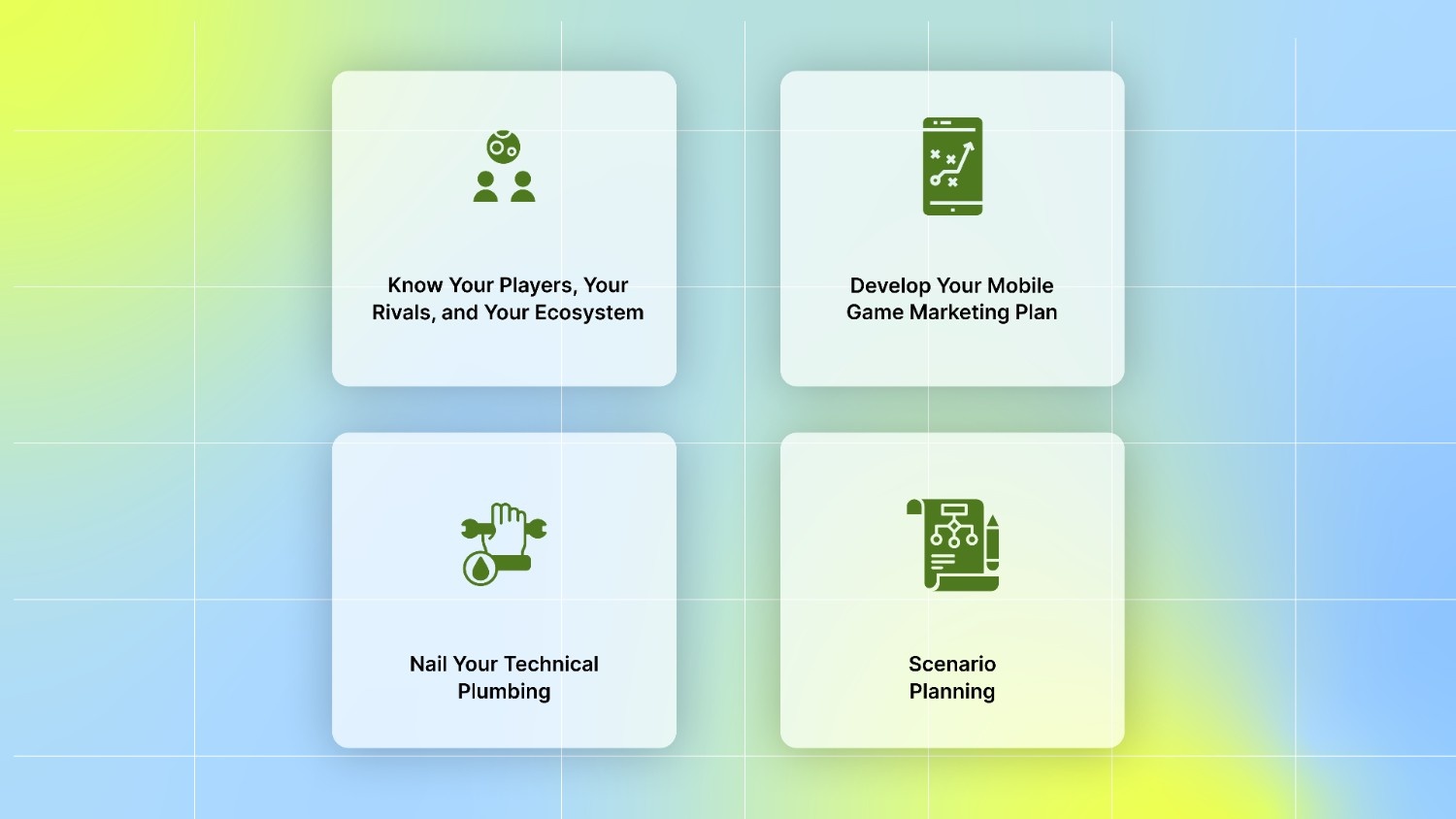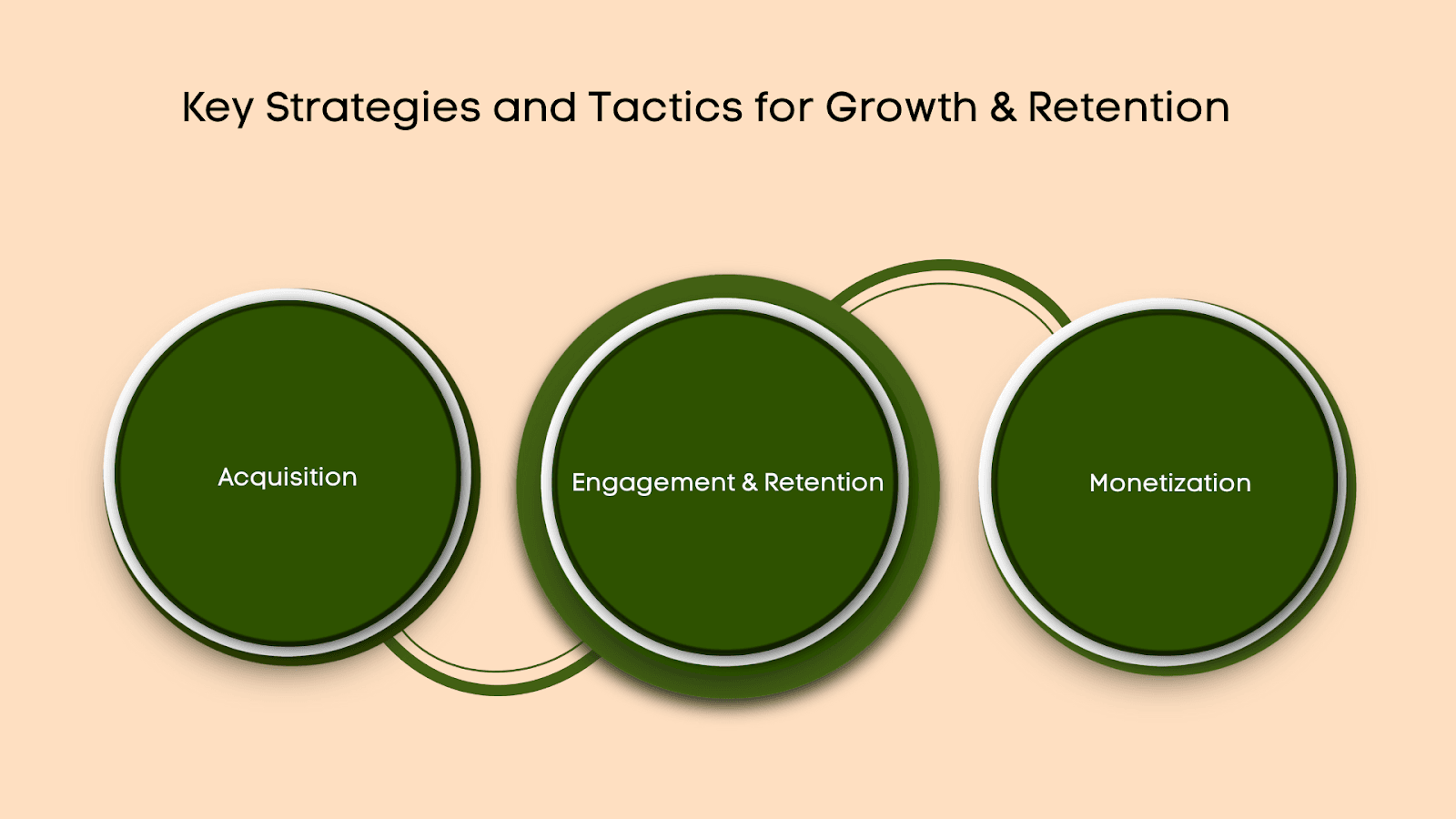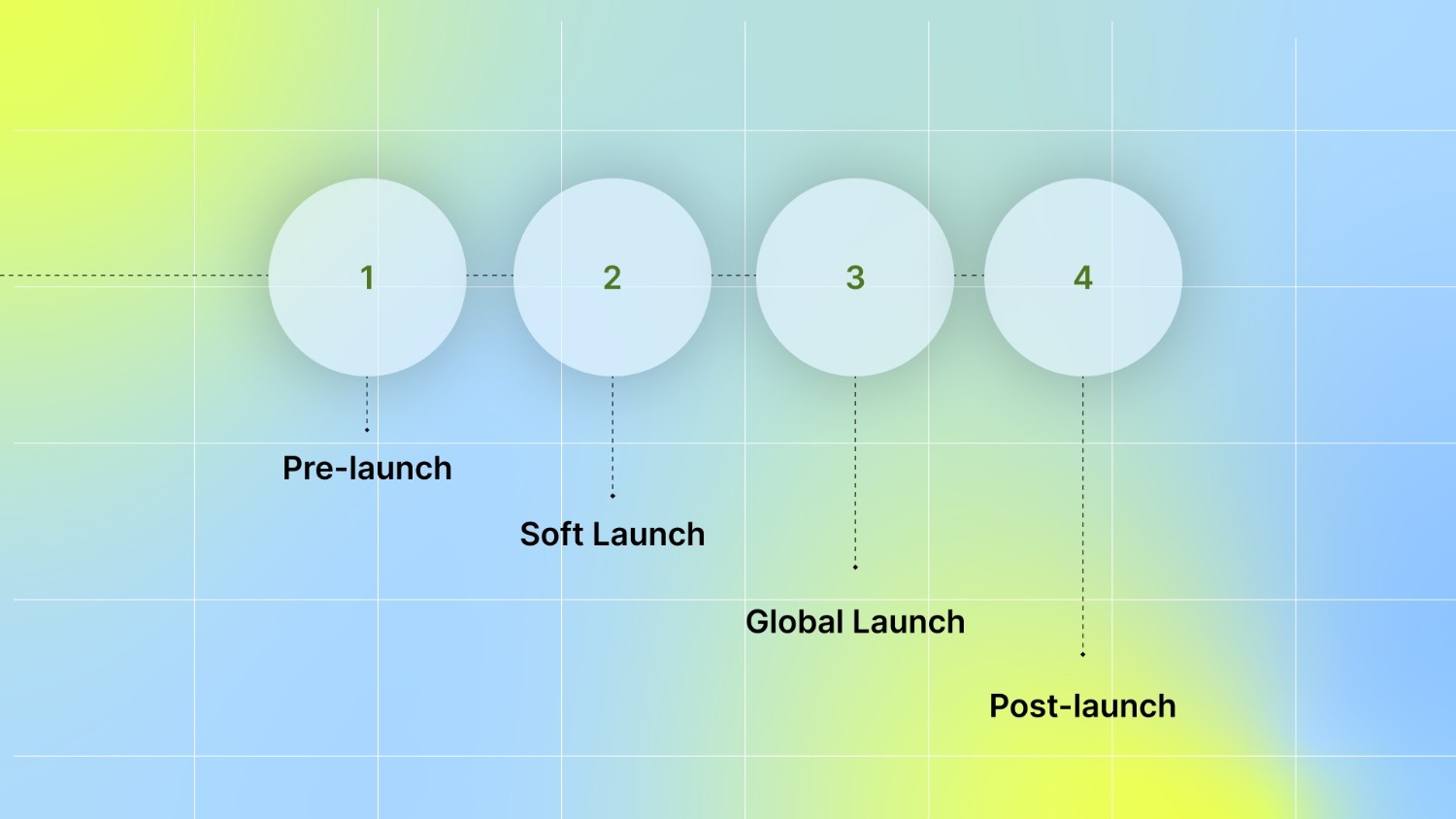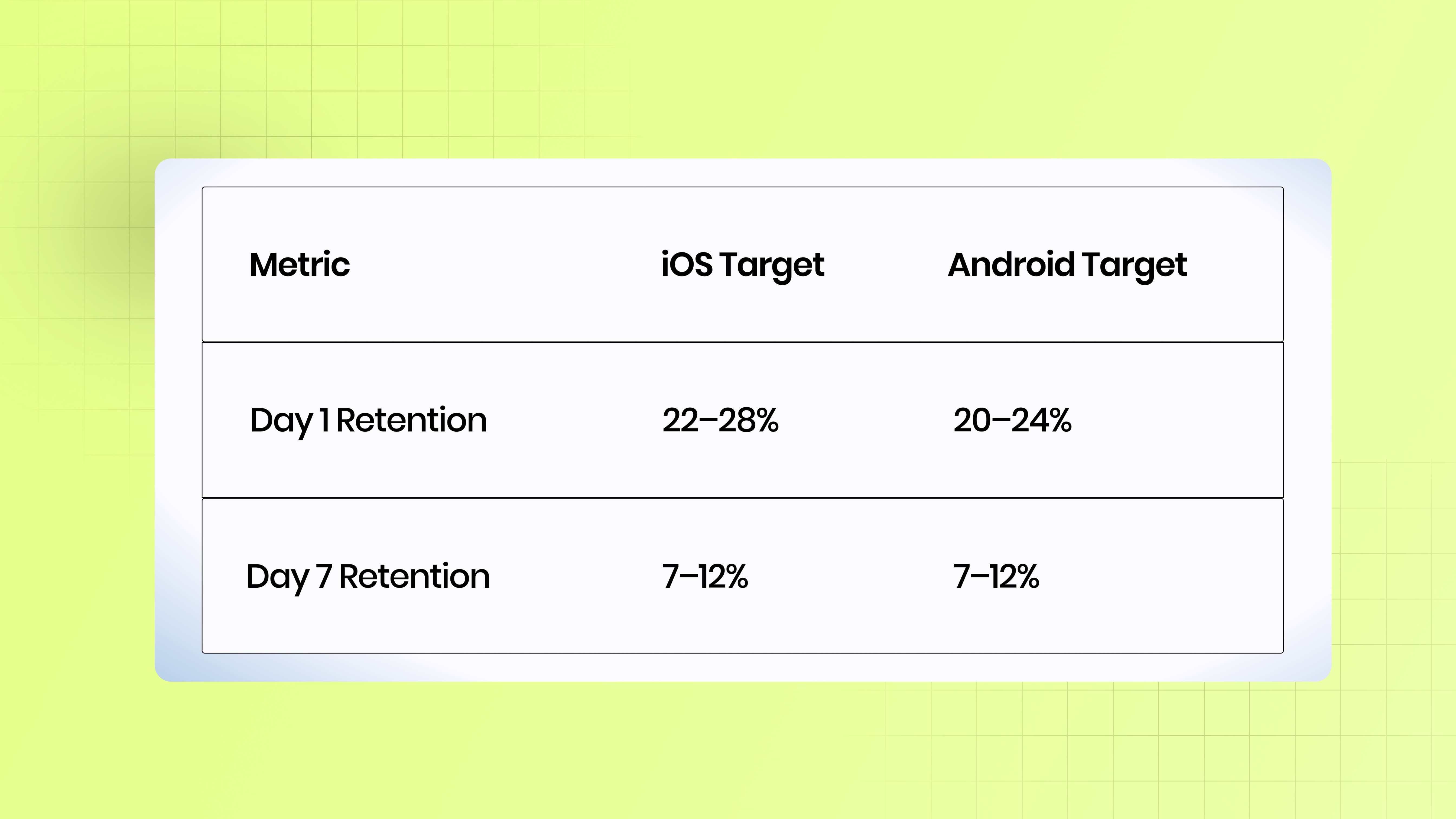Essential Mobile Game Marketing Strategies Guide
Mobile games generated $92 billion in 2024, accounting for 49 % of the $187.7 billion global games market and marking a 3 % increase year over year. Meanwhile, in 2024, global in-app purchase and subscription revenue grew 13 %, reaching $150 billion, despite a 6 % decline in total downloads to 49.6 billion. This shift underscores that while studios may still chase installs, it’s the depth of engagement and monetization per user that now drives the lion’s share of mobile game earnings.
A focused mobile game marketing plan that combines precise user-acquisition tactics, smart app-store optimization, and active community building can drive high-quality installs, lower cost-per-acquisition, and build lasting player loyalty.
We’ll break down key parts of a mobile game marketing strategy, such as paid campaigns, ASO, influencer outreach, and community seeding. Then, we’ll cover setup steps like market research, SDK integration, and planning. Finally, we’ll share tips for measuring results and refining for maximum lifetime value.
What is Mobile Game Marketing?
In practical terms, mobile game marketing involves promoting your game to attract new, high-quality players at the lowest possible cost. The goal is to hit an efficient Cost-Per-Install (CPI) while maximizing Lifetime Value (LTV) and Return on Ad Spend (ROAS) through precise User Acquisition (UA) tactics and measurement.
Full-Funnel Mobile Game Marketing:
Acquire: You run campaigns on Meta, Google App Campaigns (formerly Universal App Campaigns), TikTok Ads, and specialized programmatic DSPs – testing different ad formats (playables, video, interstitials) and creatives via A/B testing or AI-driven creative optimization. You set clear CPI and ROAS targets and monitor them proactively.
Engage & Retain: You onboard new players with streamlined tutorials and early rewards, then deepen engagement with push notifications, in-app messages, and live-ops events. You deploy re-engagement offers and segmented messaging for users who drop off to bring them back.
Monetize:
Designing in-app purchase (IAP) bundles and pricing tiers based on player segments
A/B-testing special offers, season passes, and time-limited bundles.
Integrating rewarded video and interstitial ads via a mediation layer to maximize eCPM without disrupting UX.
Tracking ARPU, ARPDAU, and LTV, and feeding performance data back into UA budget allocation.
Core Strategies for Effective Mobile Game Marketing:
Paid Advertising: Control spend on CPI, optimize creatives, and diversify channels.
Organic Growth: Crafting a concise title with primary keywords in Apple’s 30-character title field (and subtitle). Localizing every metadata field (keywords, long description, screenshots) per region. Testing icons and preview videos via Google Play Experiments or Apple Search Ads Creative Sets to boost CVR.
Influencer Campaigns: Partner with streamers or creators whose audiences match your player personas, then amplify those collaborations with paid boosts.
Now that we know the core elements, let’s examine why this approach is crucial for your game’s growth.
Why Mobile Game Marketing is Crucial?
You need mobile game marketing because it’s the engine that turns your great game into a growing, profitable business:
Discovery Is Hard: With hundreds of thousands of games available, building a great product isn't enough; discoverability requires dedicated effort.
User Acquisition Costs Are Rising: CPIs vary and continue to increase, necessitating optimization across the entire funnel.
Monetization Needs Precision: Balancing free-to-play models with revenue flow requires personalization, not intrusive tactics.
Retention Drives Success: Marketing must extend beyond acquisition to build long-term loyalty.
LTV Fuels Scalable Growth: A higher Customer Lifetime Value (LTV) enables more aggressive and sustainable acquisition investments.
Data-Driven Marketing Is the New Standard: Growth teams must track real-time behavior, A/B test, and personalize engagement across channels.
Marketing Drives Installs: Effective marketing helps users discover your app and motivates them to download it.
Marketing Expands Revenue Channels: Marketing can optimize various monetization methods, including in-app purchases (IAPs), rewarded ads, and subscriptions.
By treating mobile game marketing as a full-funnel discipline that spans from ASO to LTV-backed UA, you'll attract, engage, and monetize the right players at scale.
Understanding its importance, the next step is setting up a solid foundation to make it all work.
Also Read: Mobile Game Advertising in 2025: Key Insights and Best Practices
Building Your Foundation: Research, Planning, and Setup

Lay the groundwork for effective mobile game marketing by following these steps from a user-acquisition (UA) perspective. You’ll sharpen your focus, reduce wasted spending, and set up reliable measurements.
1. Know Your Players, Your Rivals, and Your Ecosystem
Market Research: Utilize data platforms like Apptopia, SensorTower, and Data.ai to identify underserved genres, regions, or player segments. Track downloads, revenue trends, and ad-spend benchmarks to uncover gaps where your game can stand out.
Define Your Audience: Go beyond age and country. Build detailed gamer personas by combining historical user acquisition data, in-app behavior, and survey insights. Complement personas with install-date cohorts and behavior cohorts (e.g., tutorial completers vs. early dropouts) using cohort analysis dashboards to pinpoint precisely when and why retention gaps occur.
Competitor Research: Play top-chart rivals, read their user reviews, and dissect their ad creatives across channels. Note their CPI bids, retention hooks, and monetization prompts to inform your own acquisition and engagement tactics.
App Store Research: Compare store dynamics. Apple users often generate higher in-app revenue, while Android users may rely more on ad-based monetization. Tailor your mobile game marketing by platform; for example, prioritize freemium on iOS and rewarded ads on Android.
2. Develop Your Mobile Game Marketing Plan
Set SMART UA Goals: Define install targets, Day-7 retention lift, and maximum CPI or target ROAS. Tie each goal to a pre-launch, launch, or post-launch phase and assign a budget accordingly.
Choose Channels and Tactics: Mix paid channels (e.g., Meta, TikTok, in-app networks) with organic levers (ASO, influencer seeding, community growth). Allocate test budgets to validate which channels hit your CPI and LTV targets.
Align Measurement: Confirm that your dashboards track installs, cost-per-install, retention curves, lifetime value, and return on ad spend. Plan regular check-ins to pivot spend if performance shifts.
3. Nail Your Technical Plumbing
SDK Integration: Install and configure your Mobile Measurement Partner (MMP) SDK (AppsFlyer, Adjust, Branch) and set up SKAdNetwork v4 postback configuration with coarse-to-fine conversion values and multiple postbacks for iOS 16.1 and above. Test via branded test ads to verify install, session, and in-app event capture. Verify that they capture installs, sessions, and in-app events without gaps.
Telemetry and Dashboards: Set up real-time dashboards to monitor CPI, retention cohorts, and LTV. Utilize marketing analytics tools to identify anomalies, such as sudden CPI spikes or retention drops, allowing you to troubleshoot quickly.
Data Integrity Checks: Run test installations, simulate in-app events, and verify that each metric flows correctly into your Business Intelligence (BI) system. Clean data ensures that you make decisions based on accurate figures.
4. Scenario Planning
Bull Case: Low CPI, strong Day-7 retention, high LTV. Plan how you’ll scale your budget rapidly if performance outpaces forecasts.
Base Case: Your expected CPI and retention. Use this to set steady-state budgets and growth pacing.
Bear Case: High CPI, weak retention, low LTV. Define thresholds for pausing or reallocating spend if performance drops below this line.
With these scenarios, you’ll avoid overspending when costs rise and be ready to accelerate when metrics improve. It’s time to explore the concrete tactics that drive installs and keep players engaged.
Also Read: Mobile Gaming App User Retention Strategies and Benchmarks
Key Strategies and Tactics for Growth & Retention

Acquisition
1. Optimize Your App Store Presence (ASO)
You make your game discoverable and save on paid user acquisition by treating your store listing as your digital shop window. In mobile game marketing, you should:
Craft a clear, keyword-rich title and description.
Select an icon that stands out at thumbnail size.
Include high-quality screenshots and a brief preview video that highlights the core gameplay.
Localize text and visuals to match regional preferences and cultural nuances.
Proactively manage reviews: thank happy players and address complaints to improve your rating.
2. Leverage Paid User Acquisition
You expand your player base fast by running targeted campaigns across ad networks. In your mobile game marketing plan:
Mix ad formats such as full-screen video, rewarded video, playable demos, static banners, and native placements to match different funnel stages.
Test geo-targeted creatives that speak directly to local audiences.
Utilize programmatic Demand-Side Platforms (DSPs) or specialist gaming networks, such as Unity Ads, ironSource, and AppLovin, to target high-quality users.
Continuously A/B test and optimize: Swap out scripts, visuals, CTAs, and measure CPI, CTR, and conversion rate.
3. Promote via Cross-Promotion & Influencers
You boost credibility and reach by:
Running cross-promotional ads inside non-competing games with similar audiences.
Partner with micro-influencers and streamers who align with your genre, and prioritize engagement metrics (comments, watch time) over follower count.
Organize live streams or giveaways where influencers showcase your game in real time, driving install spikes.
Engagement & Retention
1. Streamline Onboarding: First-Time User Experience (FTUE)
Your players stick when their first session feels smooth. In your mobile game marketing toolkit:
Remove unnecessary permissions and delays at install.
Use contextual walkthroughs that adapt to how players progress, rewarding them early.
2. Build a Strong Community
You turn players into advocates by:
Hosting and moderating spaces on Discord, Reddit, or in-game chat.
Running LiveOps events such as seasonal challenges and time-limited modes to create FOMO and fresh talking points.
Collecting feedback, recognizing top contributors, and sharing sneak peeks to foster loyalty.
3. Encourage UGC & Referrals
You amplify your reach organically by:
Adding easy share buttons for clips, screenshots, or user-created levels.
Launch referral codes or links that grant both parties in-game currency or exclusive skins; measure invite conversion and LTV lift to optimize reward levels.
Promoting top UGC on your social channels to validate community creativity.
4. Re-Engage with Behavior-Based Messaging
You bring players back by:
Sending personalized push notifications based on in-game milestones or lapsed activity.
Displaying in-app messages highlighting fresh content or events when they reopen the game.
Monetization
1. Balance Monetization with Player Experience
You sustain revenue when offers feel natural, not intrusive. In your mobile game marketing:
Time IAP prompts around natural breaks (after a win, at level-up).
Personalize offers using first-party data—tailor bundles to their progression.
Favor F2P models with smart in-app purchase mechanics (battle passes, limited skins) over aggressive paywalls.
2. Use Rewarded Video Ads Strategically
You increase both retention and ARPU by:
Offering optional video ads in exchange for small rewards (lives, currency).
Placing rewarded videos in contexts where players naturally need a boost.
Also, feed rewarded-video placement data into your ad monetization platform (e.g., Unity Mediation) to dynamically optimize eCPM floors and waterfall placement, improving ad revenue and retention.
3. Explore Hybrid Monetization
You diversify income by combining:
In-app purchases, subscriptions, and in-game advertising.
Special event-based offers tied to seasons or collaborations (e.g., movie tie-ins).
By applying these targeted mobile game marketing strategies across Acquisition, Engagement, retention, and Monetization, you’ll attract the right players, keep them engaged, and maximize long-term revenue while lowering your overall UA costs.
Let’s map out how to apply those strategies through each stage of the game’s launch and beyond.
Also Read: Top Mobile Gaming App Marketing Strategies You Must Know
Planning Your Mobile Game Marketing Around the Full Lifecycle

1. Pre-launch:
Before you spend on ads, verify your tracking and test your pitch. In the pre-launch phase, you should:
Run small market tests to spot which ad creatives and messages drive installs.
Seed your community with a waitlist or closed beta to collect early feedback and spark word-of-mouth.
Share teaser content on social and partner with a handful of niche influencers to build hype.
Offer early access via exclusive sign-ups to capture qualified leads and collect behavioural signals.
2. Soft Launch:
Treat your soft launch like a technical and marketing dress rehearsal. You want clean, reliable UA data and proof that players stick around:
Technical Stability: Test server load, crash rates, and bandwidth under real-world traffic. Ensure all SDKs and analytics tools are integrated and send accurate installation and event data.
Retention Testing: Measure retention on Day 1, Day 7, and Day 30. Use A/B tests on your tutorial and onboarding flows to boost early engagement.
Monetization Testing: Track ARPU, IAP conversion rates, and ad-based revenue. Experiment with economy tweaks, limited-time offers, and rewarded video incentives.
Avoid high-variance ad networks during soft launch. Stick to stable first-party channels (Meta, TikTok) to get representative UA data you can trust.
3. Global Launch:
When you roll out worldwide, align your paid UA, influencer partnerships, referral offers, and ASO to drive install momentum:
Paid UA: Spread budget across first-party ad platforms (Meta, TikTok, Snapchat) and rewarded video networks (IronSource, AppLovin). Monitor CPI and optimize bids by region and format.
Influencer Partnerships: Activate larger-scale influencer campaigns on YouTube and TikTok. Use custom tracking links or codes to measure lift in installs.
Referral Programs: Incentivize existing players with in-game rewards for each friend they invite. Track invite codes to attribute installs and reward both parties.
App Store Optimization: Based on early feedback, update your app icon, screenshots, and keywords. Use A/B tests in Apple Search Ads or Google Play experiments to boost conversion rates.
4. Post-launch:
After launch, shift from pure UA to keeping players engaged and spending:
Push & In-App Messaging: Send behaviour-based notifications for unfinished tutorials, upcoming events, or special offers. Personalize messages to match each segment’s play style.
Email Automation: Re-engage lapsed users with timed campaigns highlighting new features or exclusive bundles.
LiveOps Events: Plan time-limited challenges, seasonal content, and leaderboard events to create urgency and boost session frequency.
Behavioural Segmentation & Upsell Flows: Group players by spend level or activity. Offer high-value bundles to engaged spenders and trial offers to dormant users to reduce churn.
Continue measuring LTV, ARPU, and churn rates. Feed these signals back into your UA channels to optimize the budget for the highest-value cohorts.
Finally, we’ll cover the metrics and frameworks you need to measure and refine your efforts and stay on track.
Also Read: Creating pLTV Framework for Mobile Games: How to Improve User Acquisition and Maximize ROAS
Measuring Success: Data and Analytics
To drive efficient mobile game marketing, you need a clear measurement framework that ties every dollar of your UA spend to real business outcomes. Here’s how you can set up and benchmark each stage of the user funnel in 2025:
1. Acquisition & ROI: ROAS and Payback
D7 ROAS Break-Even: Set your Day-7 ROAS target at 100% (1:1) to cover your ad spend within a week. If you miss this, lower your bids or tighten audience targeting.
D30 Payback: Extend to a Day-30 payback goal for full profitability. Your cohorts should hit 100% ROAS by D30 to validate long-term spending.
LTV: CAC Ratio: Ensure your Lifetime Value to Customer Acquisition Cost ratio is ≥ 3:1. If CAC creeps up, push on retention and IAP funnels instead of raising bids.
2. Engagement: Stickiness and Session Quality
DAU/MAU Ratio: Maintain a ≥ 20% stickiness (DAU divided by MAU). If it dips, refine your core loop or social invites.
Session Time: Aim for 10+ minutes total play time per active user daily. Shorter sessions signal friction, test tutorial tweaks, or early rewards.
3. Retention: Platform-Level Benchmarks

Your Action: If D1 retention falls below these ranges, overhaul onboarding—shorten tutorials, clarify rewards, A/B test messaging. To push D7 above 7%, deploy timed events or mini-quests on days 3–5 to pull players back in.
Pro Tip: In 2025, competitive midcore titles aim for Day 1 ≥30 % on iOS and ≥25 % on Android; Day 7 ≥10 % is table stakes for funding-worthy projects.
4. Monetization
ARPU (Average Revenue Per User): Free-to-play games often fall in the $1–$5 ARPU range, but hybrid casual genres can hit $2.99–$4.90 when ads and IAP mix well. Test stronger IAP offers or interstitial placement if your ARPU is under $1.
LTV (Lifetime Value): Top iOS games record an LTV of nearly $2.93 per user. Use that to set your maximum sustainable CPI—if CPI exceeds LTV, campaigns will lose money.
IAP Conversion: Strive for a 1–5% purchase rate. Below 1%, your pricing or offer timing probably needs recalibration (bundle discounts, limited-time bundles).
5. Feedback
Ratings & Reviews: Set up alerts for 4-star and below reviews. Aim to reply to or address common complaints within 48 hours; fast responses can improve your store conversion.
NPS (Net Promoter Score): Track NPS quarterly. Many top mobile apps land between +30 and +50; if you sit under +20, survey users on key friction points (bugs, UI, ad load).
6. Analyzing User Behavior:
Begin by instrumenting your analytics to pinpoint where players drop off and where they spend. For example, track tutorial completion and level-3 exit rates, then compare them against industry retention benchmarks: to stay competitive in mobile game marketing, aim for ≥35.7%Day-1 retention on iOS and ≥27.5% on Android.
7. A/B Testing / Split Testing:
Run regular store-page and ad creative experiments. Use Google Play Experiments and Apple Search Ads Creative Sets to swap icons, screenshots, and preview videos for store listings. Allocate at least 5,000 unique impressions per variant to reach statistical confidence. Prioritize tests around your most significant funnel leaks. For instance, if your IAP opt-in is under 8%, test alternative messaging or button placement until it lifts by 10–15%.
8. Mobile Marketing Attribution:
Implement both deterministic (IDFA) and probabilistic attribution via a Mobile Measurement Partner (MMP). With App Tracking Transparency (ATT) limiting IDFA, target a 40 %+ opt-in by prompting users contextually after seeing value in your game. Use SKAdNetwork v4 as your iOS installation source-of-truth (with fine-grained conversion values), and complement with MMP probabilistic modeling for Android and fallback windows; maintain a >40 % ATT opt-in rate by prompting users post-tutorial when the value is clear. Use First-Touch to measure broad reach, Last-Touch for performance channels, and Multi-Touch to allocate credit across your ad stack.
9. Organic Uplift:
Run hold-out experiments to quantify the impact of paid campaigns on your organic baseline. According to recent research, every 100 paid installs generate ~3 extra organic installs, resulting in an 8% uplift that can be attributed to paid-driven chart boosts and word-of-mouth. Segment this by OS and region to identify where your paid spend creates the highest spillover, then reallocate the budget to those geos.
10. Media Buying Models:
Understanding how you pay for ads (CPC, CPM, CPI, CPA) is crucial for effective ad spending. Instead of just installs, use post-install events (e.g., tutorial completion, IAP) to define acquisition.
11. Tools:
Rely on a combination of attribution and analytics platforms (AppsFlyer, Adjust, Singular, Gamesight, Upptic) and platform-specific tools (Meta, TikTok, Google Ads, Apple Search Ads, Unity/IronSource, AppLovin).
Also, integrate emerging real-time anomaly-detection services (e.g., Data.ai Alerts, now acquired by Sensor Tower) and creative-intelligence platforms (e.g., Segwise.ai) to automate performance and creative optimizations.
Incorporating these benchmarks and tactics into your UA playbook will ensure that your mobile game marketing is data-driven, cost-efficient, and continuously optimized.
Conclusion
The mobile gaming market’s rapid growth has made standout performance more critical and costly than ever. Studios must combine paid ads with innovative organic strategies and community outreach to attract the right players, retain them, and increase their overall value. That means setting clear goals for cost-per-install (CPI) and return on ad spend (ROAS) across all channels, testing different ad versions to determine what works best, optimizing your store listing with the right keywords and localizations, and utilizing targeted push notifications, in-app messages, and live events to engage players.
Just as important is using data: set up and check your tracking tools, create live dashboards to watch your CPI and retention, and plan for best-, middle-, and worst-case scenarios so you can ramp up spending when things go well or pull back when they don’t.
Start your 14-day free trial of Segwise AI today to automate creative analytics, safeguard your ad spend, and accelerate high-quality user acquisition.
FAQs
1. What’s the ideal pre-launch timeline for mobile game marketing?
Aim to kick off marketing activities like teaser campaigns, waitlist sign-ups, and closed betas about 3–6 months before your global launch to build awareness and gather early feedback without burning out interest.
2. How do “playable ads” differ from other ad formats?
Playable ads let users interact directly with a mini-version of your game in the ad unit, driving higher-quality installs and better post-install engagement than static or video ads.
3. What’s a good rule of thumb for swapping ad creatives to avoid fatigue?
Rotate or refresh creatives after roughly 3–5 impressions per user (or every 1–2 weeks in high-volume campaigns) to maintain engagement and prevent declining click-through and install rates.
4. How should I select influencers for my game’s genre?
Prioritize micro-influencers whose audience demographics align with your player personas and whose engagement rates (comments/watch time) consistently outperform follower counts.
5. Which KPIs matter most during a soft launch?
Focus on Day-1/Day-7 retention, tutorial completion rates, and ARPU benchmarks; these reveal whether onboarding, engagement hooks, and monetization are healthy before scaling paid spend.
Comments
Your comment has been submitted successfully!